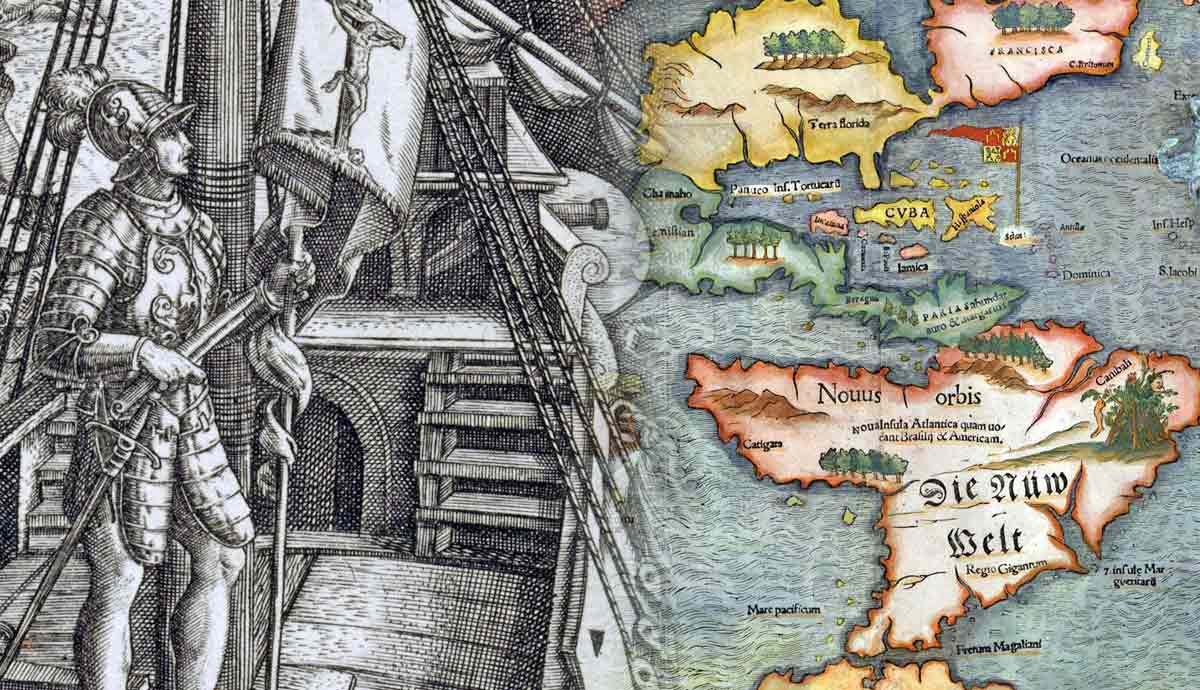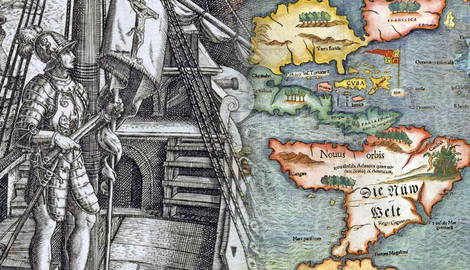
The impact of European colonization on the environment is a topic not widely considered. While much attention has been paid to the consequences for native human populations, particularly the cultural aspects, ecosystems have gone unnoticed. Nature, however, is also a central actor in historical processes. The role it played and how it changed after the arrival of the new settlers, along with their diseases, plants, and animals continues to impact life in the Americas to this day.
Furry Colonizers: The First Expansion

In the early 15th century, the first Portuguese colonizers, seeking lands to settle, arrived in the present-day Madeira Archipelago, situated in the Atlantic off the coast of North Africa. The two islands of the archipelago were untouched, uninhabited, and devoid of any signs of human occupation, not even from the Paleolithic or Neolithic eras. When they first arrived, determined to conquer the island that is now Porto Santo in 1420, the captain came up with the idea of releasing a few rabbits that had reproduced on the ship. These small animals were very common on the Iberian Peninsula, so they didn’t think much of it. However, on this virgin island, full of lush and appetizing grass, without any predators or pathogens, they began to multiply uncontrollably and eat anything their human counterparts planted.
The Portuguese were not going to let these furry colonizers take over their island so they grabbed their weapons, attacked their burrows and killed as many rabbits as they could. Their efforts were in vain, as they were unable to stop them, leaving them no choice but to abandon the island. This wasn’t the only time furry colonizers compromised European colonization efforts—it would happen again later in Australia.

The Portuguese moved to the neighboring island, now Madeira, free of rabbits, but faced with the problem of a virgin island densely populated with trees and no place to settle. Even the name they gave it, Madeira, wood, refers to the island’s vast forests. Lacking the patience to start cutting down trees, they decided to set the island on fire. Accounts say the resulting fire nearly engulfed the entire island, forcing inhabitants, including children and women, to seek refuge in the sea, with water up to their necks for two days and two nights without food or drink. It’s said the fire lasted for seven years.
The conquest of these islands, marking the beginning of European expansion, showcases the great ignorance that existed about the environment. It inaugurated a very particular process of colonization that would later become a constant: the destruction of the native environment, including peoples, plants, and animals, and the introduction of new European flora and fauna, both intentional and accidental. The Europeans strove to create new homes that resembled their native lands, while being unaware of the bacteria and organisms they carried with them, which would often prove deadly to the rest of the world.
The Europeanization of the New World

The first settlers can be imagined as a group embarking on an unknown destination, hopeful to leave their misery behind and find a piece of land to cultivate, to ultimately settle down for a peaceful life. Filled with anticipation yet also fear, they were beginning anew in a distant, unfamiliar place, knowing only their lives in Europe—familiar diets, animals, landscapes, and people. They carried not just their belongings, but also their ideas, traditions, architecture, agricultural practices, and other aspects of their culture. Their aim was to recreate a familiar environment reflecting their roots and providing comfort in the new world.
During his second voyage to the island of Hispaniola, one of the earliest European settlements in America, Christopher Columbus brought along various seeds in order to cultivate European staples such as wheat, chickpeas, melons, onions, grapes, and sugarcane, among others. Initially, the climate seemed ideal and the crops grew in record time. However, the most important crops for the Spanish diet—wheat, grapes, and olives—failed to thrive, resulting in no wine or oil, a great disappointment. Nonetheless, they did not have to completely adapt to the native diet as other fruits flourished, such as bananas from the Canary Islands, and vegetables like cauliflower, cabbage, radishes, lettuces, and fruits like oranges, pomegranates, and figs. With these additions, the European diet in this new world retained something familiar that reminded them of home with each bite.

The importation of native plants was not limited to personal consumption. Since the conquest of Madeira and the Canaries, it was discovered to be highly profitable to use large expanses of land to cultivate products like sugarcane or cotton for export to Europe. This system, combined with strict exploitation and slavery, greatly contributed to colonial economic development. Initially, the native population was subjected to this system, but in some places, exhausting work coupled with diseases introduced by Europeans such as smallpox, as well as economic and social upheaval and wars, resulted in the deaths of many people during the first century and a half of the conquest. This necessitated the importation of slaves from Africa, and later, animals as well.
Within just a few generations, most of the native population of the Americas had disappeared, with estimates suggesting that around 20 million people died after the European invasion, representing approximately 95% of the total population. Just as with gold and silver, the exploitation of the new crops deprived indigenous peoples of their lands, nearly exterminating them along with their traditional ecological knowledge and sustainable land management practices. In their absence, deforestation, mining, and agriculture ravaged the ecosystem.
The Invasion of Domesticated Animals

When the Spanish arrived in the Americas, they were amazed by the contrast of the landscape and plants compared to those of their homelands. They had never seen anything like it. Christopher Columbus, very surprised upon his arrival, said, “I saw neither sheep nor goats nor any other animal … there were dogs that never barked … all the trees are as different from ours as day from night, and the same with the fruits, grass, stones, and everything else.” It was as if they had arrived in a completely different world. The animals in particular, most notably the domesticated ones, were very different.
Europeans were very accustomed to having animals at their service—horses for riding or donkeys for carrying loads—which made the complete absence of such animals in the New World especially surprising. The natives had only domesticated a few animals, including dogs, guinea pigs, turkeys, and ducks; none of these animals could be used for carrying goods, herding, or their skins. The only exception was a part of South America where they had domesticated relatives of camels: llamas and alpacas, which were revered and used for transporting food and other materials, as well as for producing cloth. Outside the Andes, transportation was accomplished solely through human strength and manual methods. Great cities like Tenochtitlan or Chichen Itza, with their grand temples and engineering projects like irrigation systems, were entirely built by man power, carrying heavy materials over long distances.

As the indigenous population dwindled, in part due to war but mostly because of diseases brought by the Europeans, the number of animals brought by the Spanish increased disproportionately. Horses, dogs, chickens, pigs, cows, and sheep were among the first to arrive and adapted very well, as there were hardly any predators, and they had many pastures to roam freely and graze at will. Small animals like dogs, chickens, and pigs, and later cats, blended easily into the daily life and economy of the indigenous people since they were easier to handle, the indigenous people already had experience domesticating small animals, and the Spanish saw no threat in them being kept by the indigenous people.
Meanwhile, larger animals like horses, cows, and mischievous pigs, reproduced uncontrollably and became feral. A very clear example was in the Argentine pampas, where the first attempts at conquest were unsuccessful. However, when the Spanish returned to Buenos Aires in 1580, there were already large herds of wild horses grazing in the region, the grandchildren of the horses that had escaped during the first attempt at conquest in the 1520s. These wild horses did not cause as much damage as the pigs and cows did, though.

Most of the indigenous peoples had a predominantly vegetarian diet, so they dedicated large areas for the cultivation of their food. The newly-arrived livestock, reproducing rapidly and with no fencing or other method to keep them under control in any one place, ravaged indigenous crops. Many native populations, already weakened after periods of war, flight, and disease, lost their food sources, and many died of hunger while these newcomers ate everything in their path.
Bartolome de Las Casas recalled how in his youth, he was surrounded by luscious grass and delicate straw that disappeared completely over the years. The arrival of these four-legged colonizers represented a very big change for an ecosystem that had not supported so many animals since before humans settled the region. In a few decades, the land lost the richness of its humus, several species of plants disappeared, and both visible and invisible organisms vanished. In fact, European and African grasslands and weeds quickly took over a huge portion of the American territory. Many species went extinct, and little is known about them today.
Ecological Legacy

The dramatic encounter between Europeans and native inhabitants of the Americas was a turning point for both cultures. Europeans discovered the existence of a completely new world that was not even mentioned in the Bible, and their astonishment at the unknown and their inability to assimilate to it became evident. On the other hand, for the native populations of the American continent, it meant the near disappearance of their existence and the world they were accustomed to.
The process of conquest must be understood beyond simplistic narratives of domination through force, as this process was not simply a clash of cultures, technology, and politics, but also a confrontation with nature. In this case, undoubtedly, the winners were Europeans and their ecosystems, as their flora and fauna survived and adapted. They also emerged victorious in the unanticipated field of biological warfare; while Europeans brought multiple deadly diseases to the indigenous peoples, very few Old World diseases are believed to have infected the colonizers.
The ecosystem transformation brought about by colonization in the Americas was so radical that it is often not fully appreciated; it was arguably the most significant biological revolution since the Pleistocene era. This alteration not only reshaped the landscape but also had profound implications for the flora, fauna, and indigenous populations of the continent. The introduction of new species, the displacement of native ones, and the disruption of established ecological balances led to far-reaching changes that continue to shape the environment and societies of the Americas to this day.










